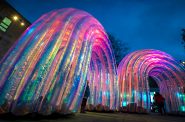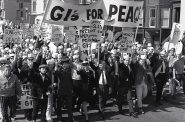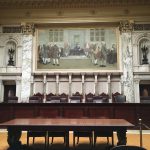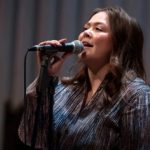MAM celebrates Calatrava addition’s 10th anniversary

The prow of the Calatrava addition to the Milwaukee Art Museum, under construction. Jim Brozek photo courtesy of MAM.
Within months of its completion in 2001, the soaring grandeur and spreading wings of Santiago Calatrava’s addition to the Milwaukee Art Museum became Milwaukee’s de facto logo. Ten years later, as museum staff prepares an anniversary show, it remains the one Milwaukee building known and celebrated throughout the world. Every day, dozens of visitors snap its picture. Every few months, some authority or publication names it to a best-of list. The museum has become a frequent location for movies and commercials. Reuters named it the sexiest building in the world, and Reuters isn’t alone in that.
“The attention began when they released Calatrava’s design in 1997, and the fanfare hasn’t subsided,” said chief curator Brady Roberts. He spoke as he led me through the musuem’s half-finished Building a Masterpiece, a show celebrating the the building and Calatrava’s creative process. It opens Thursday (Sept. 8).
The show includes many of Jim Brozek’s photos of the construction process, video installations that animate aspects of the construction and operation of the building, and a remarkable two dozen or so drawings/watercolors by the architect. A series of architectural models in the show reveal how Calatrava’s thinking evolved and, to a lesser extent, how he interacted with the museum’s board and donors between the commission, in December of 1994, and the final design in 1997.
The elegant spine of the building, with bridge, mast and prow, shows up in the earliest and simplest model.
“This first piece is more sculpture than architectural model,” Roberts said. “It’s so highly abstracted.”
That model looks very little like the finished product, but all the principles are in place. Calatrava never abandoned the basic ideas he outlined in it: (1) Placement of the weight on a fulcrum-like assembly off the center, where the east footing of the bridge meets the west entrance of the museum; (2) using the bridge to counterbalance the new pavilion building and vice-versa; and (3) connecting the museum and the lake front with downtown by spanning the 24-foot drop and, in a sense, extending Wisconsin Avenue to Lake Michigan.
Roberts said that Calatrava’s next breakthrough had to do with animating the building. Motion is a Calatrava signature. Sailboats on the lake in part inspired his design, and boats move and have moving parts. Dynamism lay in the conceptual DNA of the building.
Models and a video animation show two preliminary ideas. In one, a shallow dome rises in relatively few wide, uniform, gently curved panels. They rise together in mirror fashion, directly from a central axis. In another preliminary design, many slender pieces rise to form a pair of feathery waves. Both are gorgeous, but neither sealed the deal. The design we know now as the Burke Brise Soleil, of slender wings of graduated length that open into wings, did.
“When Calatrava brought that in, the board and everyone else knew they had to build it,” Roberts said. “That was the galvanizing idea.”
Calatrava, we should keep in mind, is no artiste who sketches out gestures and leaves it to others to make his building stand up. Roberts noted that the architect holds a doctorate in structural engineering and was hands-on throughout this project, his first in America. He did not just dream up the building; he knew how to make it.
Later, outside, Roberts pointed to the boomerang brace and the giant, inverted hammer that tie the bridge to the ring beam and to the bridge. The mast rises from them, and a network of cables run from the mast to the bridge. It’s all beautiful, but also structural. The building stands not only on massive support, but on unshakeable poise.
“Ring beam, hammer, boomerang,” Roberts said. “These terms did not exist in architecture before this building.”
The Baumgartner and Schroder Gallerias, the long promenades on the east and west that connect the pavilion with the Kahler and Saarinen buildings to the north, are more intimate than Windhover Hall and more traditionally planted on the ground. But they, too, are engineering marvels, with their arrays of ribs that support the gently arcing roof above the promenades and the gallery and shop space between the gallerias. Each of those ribs required unique casting, special processes to come out of the forms smooth and unmarked, and absolutely perfect placement.
Even the underground parking garage is lovely in this place.
“To Calatrava, everything was an aesthetic opportunity,” Roberts said. “There was no compromise in this building.”
To those of us who were around when the building was planned and constructed, the models and the engineering details are refresher courses. The building itself doesn’t really need a celebration, as public and expert appreciation have been intense and unbroken since 2001.
The unique and new contribution of Building a Masterpiece will be tucked into a cozy gallery in the good old Saarinen building on the north end of the complex. Perhaps two dozen Calatrava drawings and watercolors will reside there through the run of the show. Several are from his student days and show his curiosity about forms and his love of Classical architecture and imagery.
The most fascinating date from his work on the Milwaukee Art Museum. They are not dry architectural renderings, but exuberant, stream-of-consciousness visual narratives in images on cheap roll paper. The museum has never displayed them before and might not again.
“He was always drawing,” Roberts said. “He would bring a roll of paper with him and just start.”
The knockout of the exhibition is a 1995 drawing/watercolor perhaps a little short of three feet high and about seven feet wide. Calatrava sketched a whimsical, colorful parade comprising the brise soleil, a sailboat, parents with a couple of kids, a cheerful face, and more.
“Seeing this gets you into Calatrava’s head,” Roberts said. “Those figures — he was so connected to people. That’s the difference between sculpture and architecture.”
People love this building, and not just for its exterior grandeur and grace. Calatrava’s museum addition is grand architecture with a human face and scale. You walk into Windhover Hall and down those gallerias and already cares fly from your shoulders. That is no happy accident. Calatrava had you in mind when he made that sketch in 1995, and he engineered happiness into Milwaukee’s favorite building.
Notes: Ironically, a giant piston is being replaced in the brise soleil mechanism and it’s not fully functional right now. Roberts said that it will be up and running in a few days.
The show runs from Sept. 8 to Jan. 1; watch the Milwaukee Art Museum website for related activities, including a lecture by an architectural expert to be announced.
MAM invites anyone who has shot digital pictures of Calatrava’s addition to enter a photo contest, with a nifty Canon S95 camera as the prize. Entries will cycle through a video display at the start of the Building a Masterpiece show.
Art
-
Winning Artists Works on Display
 May 30th, 2024 by Annie Raab
May 30th, 2024 by Annie Raab
-
5 Huge Rainbow Arcs Coming To Downtown
 Apr 29th, 2024 by Jeramey Jannene
Apr 29th, 2024 by Jeramey Jannene
-
Exhibit Tells Story of Vietnam War Resistors in the Military
 Mar 29th, 2024 by Bill Christofferson
Mar 29th, 2024 by Bill Christofferson

























